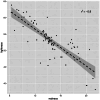Genomic prediction for potato (Solanum tuberosum) quality traits improved through image analysis
- PMID: 39256988
- PMCID: PMC11628938
- DOI: 10.1002/tpg2.20507
Genomic prediction for potato (Solanum tuberosum) quality traits improved through image analysis
Abstract
Potato (Solanum tuberosum L.) is the most widely grown vegetable in the world. Consumers and processors evaluate potatoes based on quality traits such as shape and skin color, making these traits important targets for breeders. Achieving and evaluating genetic gain is facilitated by precise and accurate trait measures. Historically, quality traits have been measured using visual rating scales, which are subject to human error and necessarily lump individuals with distinct characteristics into categories. Image analysis offers a method of generating quantitative measures of quality traits. In this study, we use TubAR, an image-analysis R package, to generate quantitative measures of shape and skin color traits for use in genomic prediction. We developed and compared different genomic models based on additive and additive plus non-additive relationship matrices for two aspects of skin color, redness, and lightness, and two aspects of shape, roundness, and length-to-width ratio for fresh market red and yellow potatoes grown in Minnesota between 2020 and 2022. Similarly, we used the much larger chipping potato population grown during the same time to develop a multi-trait selection index including roundness, specific gravity, and yield. Traits ranged in heritability with shape traits falling between 0.23 and 0.85, and color traits falling between 0.34 and 0.91. Genetic effects were primarily additive with color traits showing the strongest effect (0.47), while shape traits varied based on market class. Modeling non-additive effects did not significantly improve prediction models for quality traits. The combination of image analysis and genomic prediction presents a promising avenue for improving potato quality traits.
© 2024 The Author(s). The Plant Genome published by Wiley Periodicals LLC on behalf of Crop Science Society of America.
Conflict of interest statement
Jeffrey B. Endelman is a member of the editorial board of The Plant Genome. Michael D. Miller worked on this research as a student at the University of Minnesota and now works for Seneca Foods Corporation. Seneca Foods did not endorse or fund this research. The remaining authors declare no conflicts of interest.
Figures






Similar articles
-
Genomic selection and genome-wide association studies in tetraploid chipping potatoes.Plant Genome. 2023 Mar;16(1):e20297. doi: 10.1002/tpg2.20297. Epub 2023 Jan 18. Plant Genome. 2023. PMID: 36651146
-
Genetic Variance Partitioning and Genome-Wide Prediction with Allele Dosage Information in Autotetraploid Potato.Genetics. 2018 May;209(1):77-87. doi: 10.1534/genetics.118.300685. Epub 2018 Mar 7. Genetics. 2018. PMID: 29514860 Free PMC article.
-
Linkage and QTL mapping for tuber shape and specific gravity in a tetraploid mapping population of potato representing the russet market class.BMC Plant Biol. 2021 Nov 3;21(1):507. doi: 10.1186/s12870-021-03265-2. BMC Plant Biol. 2021. PMID: 34732129 Free PMC article.
-
Improving Genetic Gain with Genomic Selection in Autotetraploid Potato.Plant Genome. 2016 Nov;9(3). doi: 10.3835/plantgenome2016.02.0021. Plant Genome. 2016. PMID: 27902807 Review.
-
Improving breeding efficiency in potato using molecular and quantitative genetics.Theor Appl Genet. 2014 Nov;127(11):2279-92. doi: 10.1007/s00122-014-2386-8. Epub 2014 Sep 4. Theor Appl Genet. 2014. PMID: 25186170 Review.
Cited by
-
Leveraging unmanned aerial vehicle derived multispectral data for improved genomic prediction in potato (Solanum tuberosum).Plant Genome. 2025 Sep;18(3):e70082. doi: 10.1002/tpg2.70082. Plant Genome. 2025. PMID: 40708258 Free PMC article.
References
-
- Agha, H. I. , Endelman, J. B. , Chitwood‐Brown, J. , Clough, M. , Coombs, J. , de Jong, W. S. , Douches, D. S. , Higgins, C. , Holm, D. , Novy, R. , Resende, M. F. R. , Sathuvalli, V. , Thompson, A. L. , Yencho, G. C. , Zoterelli, L. , & Shannon, L. M. (2024). Genotype‐by‐environment interactions and local adaptation shape selection in the United States National Chip Processing Trial. Theoretical and Applied Genetics, 137(5), Article 99. 10.1007/s00122-024-04610-3 - DOI - PMC - PubMed
-
- Bonar, N. , Liney, M. , Zhang, R. , Austin, C. , Dessoly, J. , Davidson, D. , Stephens, J. , McDougall, G. , Taylor, M. , Bryan, G. J. , & Hornyik, C. (2018). Potato miR828 is associated with purple tuber skin and flesh color. Frontiers in Plant Science, 9, 1742. 10.3389/fpls.2018.01742 - DOI - PMC - PubMed
-
- Bradshaw, J. E. (2017). Review and analysis of limitations in ways to improve conventional potato breeding. Potato Research, 60(2), 171–193. 10.1007/s11540-017-9346-z - DOI
-
- Buhrig, W. , Thorton, M. K. , Olsen, N. , Morishita, D. , & McIntosh, C. (2015). The influence of ethepon application timing and rate on plant growth, yield, tuber size distribution, and skin color of Red LaSoda potatoes. American Journal of Potato Research, 92, 100–108. 10.1007/s12230-014-9417-5 - DOI
-
- Bykova, I. V. , Shmakov, N. A. , Afonnikov, D. A. , Kochetov, A. V. , & Khlestkina, E. K. (2017). Achievements and prospects of applying high‐throughput sequencing techniques to potato genetics and breeding. Russian Journal of Genetics: Applied Research, 7(7), 736–743. 10.1134/S2079059717070036 - DOI
MeSH terms
Grants and funding
LinkOut - more resources
Full Text Sources

